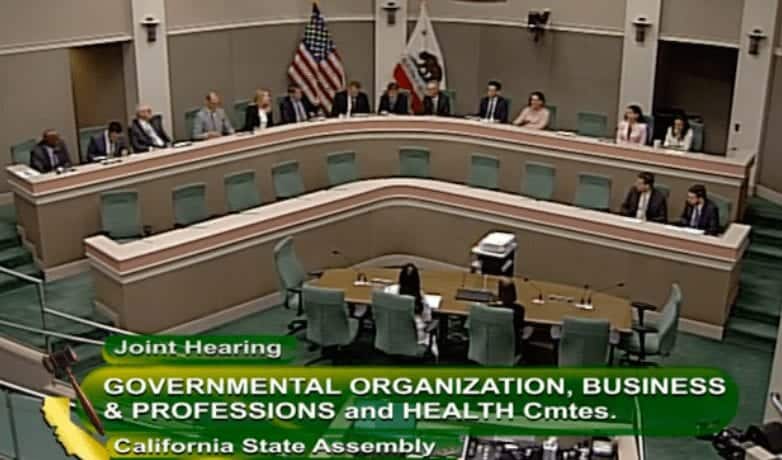 October 17, 2019 – Three California Assembly committees held a joint informational hearing on “Vaping Tobacco and Cannabis Products: Health Effects and Deficiencies in Regulation and Current Law” yesterday in Sacramento.
October 17, 2019 – Three California Assembly committees held a joint informational hearing on “Vaping Tobacco and Cannabis Products: Health Effects and Deficiencies in Regulation and Current Law” yesterday in Sacramento.
Committee chairs Evan Low (Business & Professions), Jim Wood (Health), and Adam Gray (Governmental Organization) made opening remarks. Wood said that he was concerned about youth vaping rates (for both nicotine and THC) and the current health crisis, saying he saw them as separate issues. Nonetheless, the issues were somewhat conflated at the hearing, as they have been throughout the crisis.
Dr. Charity Dean, the acting director of the state Department of Public Health, was the final speaker and she had some sobering news: there have now been three deaths reported in California related to the vape crisis, and one person who became ill from vaping reported buying vapes in two different licensed cannabis retailers. This is the first report of an illness possibly linked to a licensed product in California. Dr. Dean said more investigation was pending.
A new report from CDPH says 113 people have contracted illnesses possibly related to unsafe vaping: 78 are “confirmed,” 55 are “probable” and 14 are “under investigation.” Over one-third of patients reported vaping multiple products with different active ingredients (THC, CBD, or nicotine) in the last three months: 81% said they vaped a product containing THC; 38% said they vaped CBD; and 47% said they vaped nicotine. Only 10% (8 people) said they vaped only nicotine. Many patients are surrendering their vape products and those are being tested in an attempt to pin down the culprit(s) as part of a nationwide effort lead by the CDC and FDA.
The committee also called on Dr. Elisa Tong, an Associate Professor of Internal Medicine at UC Davis, and Kimberlee Homer Vagadori, MPH, project director for the California Youth Advocacy Network to provide, “An overview of the vaping and electronic cigarette industry: its rapid rise in popularity and the current regulatory landscape.” Dr. Tong explained that while flavored tobacco products have long been widely banned (except for menthol and mint flavors), regulations haven’t caught up with nicotine vape products, and marketing efforts allegedly aimed at youth had undermined years of efforts to bring nicotine use down among teens who are attracted by flavors.
Tong presented charts based on CDPH Adult Tobacco Surveys from 2016-2018 showing that while smoking cigarettes is declining among adults in California, the use of e-cigarettes, tobacco, and marijuana by young adults have been rising in recent years. Interestingly, vaping marijuana has only risen among college students, and not in young adults who are not in college. California’s youth marijuana use was reported to be slightly higher than tobacco or e-cigarette use, and since the majority of current illnesses seem to be related to illicit cannabis vaping, sometimes in combination with nicotine, this is of concern in the current crisis.
Ms. Vagadori said there are currently 44 local ordinances in California banning flavored tobacco, one of which also bans flavored THC vapes. Two cities have a moratorium on e-cigarette sales and one (Livermore) has a ban. The city of Beverly Hills bans all tobacco sales, with the exception of a few cigar bars. Many of these local laws have passed since the reports of severe health issues and deaths from vaping have occurred.
Mr. Gray asked why, if the majority of the current acute health issues are related to THC vaping, tobacco has mostly been targeted by local jurisdictions. Vagadori replied that tobacco tax dollars (currently $2.79/pack) have enabled the tobacco-control forces to activate in their local jurisdictions. Assemblyman Cooper said that of the $2 billion in tobacco tax revenue in CA, less than 3% is given to enforcement. He called for more support for local sting operations as are done for alcohol, since it was reported that some 34% of teens are buying nicotine e-cigarettes from smoke shops, and others from gas stations or other stores, as well as scoring them from their friends.
A second panel titled, “How Vaping and Electronic Cigarettes are Regulated in California (and what more needs to be done?)” featured Susan Fanelli, acting director of the CA Dept. of Public Health, Lori Ajax from the Bureau of Cannabis Control, Nicolas Maduros from CDTFA, plus Senior Assistant Attorneys General Karen Leaf (Tobacco) and Harinder Kapur (Cannabis) from DOJ.
After their presentations, a discussion ensued about the black market for THC, with Assemblypersons Cooper and Gray lamenting that the legislature has been too lenient on marijuana; that the penalties for unlicensed marijuana sales are mostly misdemeanors; and that forfeiture isn’t being used enough. DOJ was asked to recommend penalty increases for marijuana crimes, and it’s likely we will see at least one bill to do that in the coming legislative session.
Mr. Low chimed in, saying that roughly 3/4 of cities and counties have banned licit cannabis product retailers, forcing consumers to the unsafe illicit market. He said that bills to lower taxation and establish local licensing parity with alcohol retailers in order to bolster the licensed market had been defeated this year.
The hearing ran characteristically long, and most of the committee members left before public comments began three hours into it, but the Chairs were on hand for most of the public comment period.
“Bans don’t work,” said Louis Han of The Arcview Group, adding, “This is the Death rattle of illegitimate producers. A ban is the exact response they’re looking for: it will shut down legitimate operators.” Laura Del Castillo of Eden Enterprises also asked the legislators not to enact “reactionary bans” but rather to focus on research, and to carefully consider and draw a distinction between artificial flavors and terpenes. Michael Wheeler of FlowKana testified, “bans and prohibition don’t work. Reduce taxation, and increase access to legal, regulated product.”
Pamela Lopez of K Street Consulting and the Silicon Valley Cannabis Alliance said there were currently only 600 licensed retailers in CA, down from 3000 that were open before Prop. 64. She asked lawmakers to make sure consumers have access to products that are licensed and safe. Sabrina Fendrick of Berkeley Patients Group noted that with 2/3 of the state banning retail sales, “it’s no wonder we’re seeing the bathtub gin of 2019, or the K2 spice.” Looking to the the UK and other European countries, she said this seems to be a uniquely American crisis, brought about by “emotionally-driven prohibitive policies that are uniquely American.” Alex Thompson of Pure Extracts (Del Rey Oaks) warned that rash action may have disastrous fallout. He suggested focusing on cutting agents, additional lab testing and consumer labeling requirements.
A young African-American man named John told the lawmakers, “A lack of enforcement isn’t the problem; it’s the lack of licensing. The major companies forget they were in the illicit market at one time. I’ve been struggling for three years to get licensed.” Mike Clements of Guild Extracts added that economic burdens have driven up prices, and that has driven people back to black market. His figures were: 3000 legal retailers before Prop. 64 and 873 legal now. “Enforce, and make compliance less costly for good actors,” was his advice.
Other industry speakers, including Jared Kilo from the United Cannabis Business Association, called for more enforcement against unlicensed entities. “Regulations are just suggestions without enforcement,” Kilo said.
After the hearing, Wood tweeted: “The large number of attendees today reminds us that #vaping is a critical issue. We can’t move on #vaping legislation right now–we’re not in session, but look for our next hearing, in November, to give us all the info we need to hit the ground running in January on legislation.”
Stay tuned. One industry expert at the hearing estimated there could be as many as 15 bills next year addressing the vape issue, either for nicotine or cannabis, or both.
